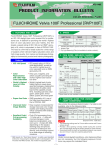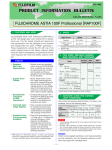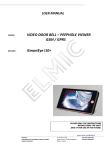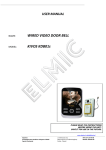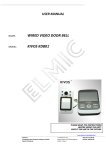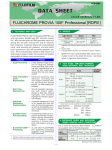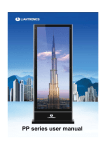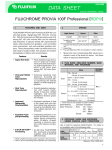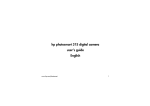Download Fujifilm Velvia RVP 100 135/36
Transcript
AF3-202E COLOR REVERSAL FILMS FUJICHROME Velvia 100 Professional [RVP100] 1. 3. FEATURES AND USES FUJICHROME Velvia 100 Professional [RVP 100] is a daylight-type high-image-quality color reversal film with an ISO speed rating of 100. In addition to the world’s highest level of color saturation, this film boasts an RMS granularity of 8, making it suitable for scenery, nature photography and other subjects that demand precisely modulated, vibrant color reproduction and high image quality. • • • • • FILM SIZES, EMULSION NUMBER, BASE MATERIAL AND THICKNESS Emulsion Base Base Number Material Thickness Sizes Features ISO 100 Speed ............. Easy-to-use ISO 100 rating with the world’s highest level of color saturation. ... Ultrahigh-saturation Attainment of the world’s Color Reproduction highest color saturation level equal to that of Velvia (ISO50) through the incorporation of new cyan, magenta and yellow couplers. Super-fine Grain .......... RMS granularity of 8, one of the finest level. ... Color Image Storage Color image storage Permanence permanence (anti-fading characteristics) equal to that of RVP 100F as a result of new couplers. ......... Minimum variation in color and Superb Push/Pull Processing gradation during push/pull Suitability processing over a range from –1/2 to +1 stop, providing an expanded range of phototaking opportunities, as well as facilitating fine adjustments in exposure and density during processing and allowing an increase in speed of up to +2 stops (equal to EI 400), depending on the scene. * RMS stands for “Root Mean Square”, a widely used standard method for measuring the degree of grain in photographic film. The lower the RMS number, the smaller the apparent grain. • Rolls* 135 ... 36-exp. ... 36-exp. (5-roll pack) 20-roll pack) 35mm × 30.5 (100 ft.) 120 ... 12-exp. ... 12-exp. (5-roll pack) 220 ... 24-exp. (5-roll pack) 127 µm Cellulose Triacetate 98 µm #460 – • Sheets* 4 × 5 in. (10.2 × 12.7 cm) ... 10 sheets and 50 sheets 8 × 10 in. (20.3 × 25.4 cm) ... 10 sheets QuickLoad 4 × 5 in... 20 sheets Polyester 175 µm * Some sizes are not available in certain markets. 4. EXPOSURE GUIDE Use a meter to determine the exposure setting. If a meter is not available, refer to the following table. Seashore or Bright Hazy Cloudy Cloudy Light Snow Scenes Sunlight Sunlight Bright Day or Conditions under Bright Open Sun Shade Lens f/16 f/11 f/8 f/5.6 f/4 Aperture (Exposure time: 1/250 sec.) NOTES • The settings are for 2 hours after sunrise and 2 hours before sunset. • Provide a lens opening 1/2-stop smaller during the summer and 1/2-stop larger during the winter (except for snow scenes). • Excessively bright (or dark) or backlighted subjects may require plus (or minus) 1-stop lens opening adjustments. 5. EXPOSURE FOR VARIOUS LIGHT CONDITIONS Daylight 2. SPEED Light Source Speed Daylight ISO 100/21° None ISO 32/16°* No. 80A** (LBB-12***) Tungsten Lamps (3200K) Under usual daylight conditions, color balancing filters are not necessary. For the following exposure conditions, however, the indicated filters are recommended. • A UV filter No. 2C* (SC-39 or SC-40)** or other appropriate ultraviolet absorbing filter is recommended for scenes that are receiving strong ultraviolet light from the sun, such as seaside locations, snow scenes, and bright distant views. Color Balancing Filter * Indicates the effective speed resulting from designated filter use. ** Wratten Filter ***Fuji Light Balancing Filter (not available in certain markets.) –1– FUJIFILM PRODUCT INFORMATION BULLETIN • FUJICHROME Velvia 100 Professional [RVP100] • Excessively high or low color temperatures may require the following filters and exposure corrections. Subject Conditions Filter Exposure Correction High Color Temperature: Cloudy weather landscapes or portraits in open shade in clear weather. No.81A* (LBA-2)*** +1/3 stop**** Low Color Temperature: Morning and evening twilight scenes and portraits. No.82A* or No.82C* (LBB-2 or LBB-4)*** +1/3 to +2/3 stop**** Fluorescent Lamp Type White (W) Color Compensating Filters* 5B+10M Daylight Cool White (D) (CW) 30R Exposure +1/2 stop +1 stop Corrections** Warm White (WW) 20M No. 80C+15M +2/3 stop +11/3 stops (Exposure time: 1/2 sec.) * Wratten Color Compensating Filters or Fuji Color Compensating Filters are recommended. NOTE: No. 80C is a Wratten Color Conversion Filter. ** Exposure correction values when using a filter relative to unfiltered exposure results. A “+” followed by a number indicates the required increase in lens opening. * Wratten Filter ** Fuji Sharp-cut Filter *** Fuji Light Balancing Filter (not available in certain markets.) **** A “+” followed by a number indicates the required increase in lens opening. NOTES • Use a shutter speed slower than 1/30 second. • For shutter speeds of 2 minutes or more, exposure adjustments will be necessary to compensate for reciprocity law failure. Electronic Flash • Electronic flash produces light similar to daylight, so filters are not needed. However, the possibility of undesirable effects on color balance, due to various factors (differences in equipment, use duration, etc.) should be taken into consideration. Test exposures are recommended. • The use of a flash meter is advisable, but the following formula can also be used to obtain a satisfactory lens opening. Tungsten Lamps • A Wratten Filter No.80A (or Fuji Light Balancing Filter LBB-12) is required when using 3200K tungsten lighting. A 1 2/3-stop larger lens opening is also required. • If household tungsten lighting (room lamps, etc.) constitutes the main source of illumination, in addition to the above filter a Wratten Filter No.82A (or Fuji Light Balancing Filter LBB-2) is required, plus an aperture increase of 1/3 stop (total 2 stops). Lens Electronic Flash Guide Number (at ISO 100) Aperture = —————————————————————— Electronic Flash-to-Subject Distance (F-number) Mixed Light Sources • Set the film speed at ISO 100. Since the amount of light reflected onto the subject from surrounding surfaces will differ with the conditions, refer to the flash unit instructions. Under mixed light conditions, the basic filter configuration should suit the main light source. In the case of cameras with TTL metering, there is no need for additional exposure compensation for any CC filter(s) used. Daylight Photoflood / Photo-Reflector Lamps • Daylight-type photoflood or photo-reflector lamp output may be lower than that indicated by the exposure meter. It is recommended to compensate for the difference by increasing the exposure time by lowering the shutter speed or by increasing the lens opening. Whenever possible, test exposures are recommended. • Other factors that should be considered when determining the exposure settings are lamp configuration, length of time used and line voltage, as they may affect lamp output and color balance. No exposure correction or color balance compensation is required for exposures within a shutter speed range of 1/4000 second to 1 minute. However, for exposures of 2 minutes or longer, ‘reciprocity law failure’-related color balance and exposure compensations are required. Fluorescent Lamps Exposure Corrections* 6. • The use of the following combinations of color compensating filters is advisable when photographing under fluorescent lighting. • For exacting work, however, test exposures are recommended because lamp brand and age may affect light output and color balance. LONG AND MULTIPLE EXPOSURE COMPENSATION Exposure Time 1/4000 sec. – 1 min. 2 min. 4 min. 8 min. Color Compensating Filter 2.5M 2.5M 2.5M + 1/3 stop + 1/2 stop + 2/3 stop None * Exposure correction values when using a filter relative to unfiltered exposure results. A “+” followed by a number indicates the required increase in the lens opening. Multiple Exposures No exposure correction or color balance compensation is required for up to four consecutive multiple exposures using an electronic flash. In the case of eight consecutive multiple exposures, a 2.5G color compensating filter is required with a 1/3- stop larger lens opening. –2– FUJICHROME Velvia 100 Professional [RVP100] • FUJIFILM PRODUCT INFORMATION BULLETIN NOTE Exposure correction values given above for long and multiple exposures are for a reversal film with an average emulsion when processed under standard processing conditions. Therefore, use the data only as a guide. For exacting work, test exposures are recommended under actual shooting conditions. 7. Store at a place (cool and dark) Short-term away from direct sunlight or high Storage temperatures and humidity. Long-term Store at 10°C (50°F) or below Storage • New building materials, newly manufactured furniture, paints and bonding agents may produce gases which could affect photographic film. Do not store film, lightproof boxes containing film or cameras or film holders loaded with film near these materials. • Film should be sealed in plastic bags* prior to cold storage. When taken out of cold storage, film should be allowed to reach room temperature before opening by letting it stand over 3 hours (for refrigerated film) or over 6 hours (for frozen film). EXPOSURE PRECAUTIONS • With artificial light, such as electronic flash, photoflood, fluorescent, tungsten, high intensity discharge lamp (metal halide, sodium, mercury vapor), etc., the lamp output and color temperature may be affected by such factors as brand, age of equipment and line voltage. Reflectors and diffusers can also influence light intensity and color temperature. • When using an accessory such as a reflector umbrella, reflector or diffuser to control light intensity or diffuse the light, the color of the light may be altered by changes that have occurred in the color or composition of the accessory’s materials or reflective surface. * Polyester, polystyrene, polyethylene, polypropylene, etc. 9. PROCESSING This film is designed for processing by Process E-6 or its equivalent, as well as Fujifilm Process CR-56. 8. UNPROCESSED FILM HANDLING / STORAGE 10. PROCESSED FILM HANDLING / STORAGE HANDLING Since the purpose of film is to provide a long-term record of memorable events, as much effort as possible has been made to use materials that exhibit the least amount of change over time, but the effects of light, heat, atmospheric oxygen, contaminant gases, humidity and mold cannot be completely avoided. It is possible, however, to minimize change in the photographic image or base material by maintaining appropriate storage conditions, such as those used by museums and art galleries. Temperature and humidity control is the most important key to minimizing the change that occurs in film. Processed film stored in the dark under the following conditions may be expected to show almost no change over time. • Expose film before the expiration date indicated on the film package and process as soon as possible after exposure. • When removing film stored at low temperatures (in a refrigerator or freezer, etc.), allow it to reach room temperature before opening it. Opening film while it is still cold may cause condensation to form on the film surface, causing color changes or the emulsion to become more susceptible to scratches. • Roll film should be loaded and unloaded quickly and away from direct sunlight. • Film loaded in cameras should be exposed and processed promptly. • Sheet film must be handled in total darkness and with care so as not to touch the emulsion surface. • X-rays inspection machines used to inspect checkedin baggage at airports can cause fogging of film. Put both exposed and unexposed film into carry-on baggage (preferably in a transparent plastic bag or a net bag that allows the film to be seen). Because of the increasing number of airports using strong X-ray machines for carry-on baggage, it is recommended that you remove film from your carry-on baggage and request a visual (manual) inspection of your film. • Film fogging may occur near X-ray equipment used in hospitals, factories, laboratories and other places where radiation is used. Always keep film away from sources of radiation. Storage Period with Almost No Change Temperature Relative Humidity More than 20 years Below 10°C 30%– 50% 10 – 20 years Below 25°C 30%– 50% (1) Color reversal film should be mounted inserted into sleeves* for storage. * Polyester, polystyrene, polyethylene, polypropylene, etc. (2) Processed film should be stored at a place as far away as possible from high temperatures, direct sunlight and other strong light. The following conditions are not desirable for the storage of film and should be avoided in the case of long-term storage: • Storage in a closet lying against a wall that is exposed to cold, outside air (where condensation may form). • Storage in an attic or on top of a closet or cabinet near the ceiling (where high temperatures may occur). STORAGE Storing exposed or unexposed film under hot and humid conditions may adversely affect the speed, color balance and physical properties of the film. Although it is best to store film at a low temperature, for practical purposes, film should be stored as follows: –3– FUJIFILM PRODUCT INFORMATION BULLETIN • FUJICHROME Velvia 100 Professional [RVP100] 11. LIGHT SOURCES FOR VIEWING 13. Use a standard transparency viewer. Visual responses will differ with light source quality and brightness. Therefore, employ a viewer which meets the ISO/ANSI standard.* Changes in density and color balance can be made by using readily available retouching dyes. In regard to bleaching, this film is as resistant to color dye fading as Velvia 100F, as a result of its improved color image stability (anti-fading characteristics). * The ISO standard (ISO 3664:2000) specifies an illuminated viewer surface with a color temperature derived from a CIE illuminant D50 (D:Daylight) with a reciprocal color temperature of 5000K, an average brightness of 1270cd/m2 ± 320cd/m2, a brightness uniformity of more than 75%, a light diffusion level of more than 90% and an average color rendition assessment value of more than Ra90. Transparency viewers should meet these standards. 12. RETOUCHING AND BLEACHING 14. SHEET FILM CODE NOTCHING A notch code identifying this emulsion type is located in the upper right-hand corner when the emulsion surface is facing toward you. The same notch is provided for QuickLoad type films. PRINTS AND DUPLICATES This film can produce high-quality prints when used with digital printers such as the Fuji Digital Minilab Frontier. High-quality duplicates can be made on FUJICHROME DUPLICATING FILM CDU TYPE II (CDU II). 15. Size 135 120 PACKAGING Item Contents Film Box New Exclusive Design Identification Color: Violet Blue Plastic Case Same as the current product (Tranparent container with a black cap). Cartridge New Exclusive Design Identification Color: Violet Blue Film Box New Exclusive Design Identification Color: Violet Blue 5 roll pack –4– FUJICHROME Velvia 100 Professional [RVP100] • FUJIFILM PRODUCT INFORMATION BULLETIN Size Item 120 Envelope Backing Paper and Seal Contents Backing paper: FUJICHROME Exclusive Design Seal: Exclusive Design ←Backing Paper ←Top Seal 220 Film Box ←End Seal New Exclusive Design Identification Color: Violet Blue 5 roll pack Envelope Backing Paper and Seal Backing paper: FUJICHROME Exclusive Design Seal: Exclusive Design ←Backing Paper ←Top Seal Sheet Film Box, Label and Seal New Exclusive Design Identification Color: Violet Blue –5– ←End Seal FUJIFILM PRODUCT INFORMATION BULLETIN • FUJICHROME Velvia 100 Professional [RVP100] 16. PROCESSED FILM EDGE MARKINGS* <Rolls> • 135 Size • 120 Size • 220 Size <Sheets> • Standard Sheet Film • QuickLoad NOTES * The emulsion is on the opposite side. (Base side facing you) ** This code represents an identification marking enabling Fujufilm’s manufacturing quality control system to assure individual quality. –6– FUJICHROME Velvia 100 Professional [RVP100] • FUJIFILM PRODUCT INFORMATION BULLETIN 17. TECHNOLOGIES INCORPORATED IN Velvia 100 17-1 PSHC (Pure, Stable & High-performance dye-forming Coupler) Technology The new-generation couplers used in Velvia 100 provide it with high color purity, stability and color formation efficiency, making possible color reproduction with unprecedented fidelity and excellent image stability. This vividness forms the basis for Velvia 100’s ability to reproduce colors with ultra-high saturation. a) X-Coupler Technology: This marks the recent use in color reversal film of Fujifilm’s new proprietary cyan coupler. b) V-Coupler Technology: New technologies have been incorporated with the V-coupler applied in Velvia 100F. c) S-Coupler Technology: In place of the yellow coupler used in FUJICHROME films providing these films with Fujifilm’s trademark color reproduction and stability, a new-generation yellow coupler has been incorporated to further boost these characteristics to even higher levels. Compared with existing FUJICHROME films, the X, V and S couplers have resulted in a drastic reduction in auxiliary absorptive components (which cause muddiness) and provide high color stability. 18. 17-2 CEL (Color-Extension Layer) Technology The Multi-layer Color Correction Layer that enabled faithful color hue reproduction in Velvia 100F has been adjusted and applied in Velvia 100 as a color-extension layer. This layer, together with new-generation couplers and adjusted gradation and spectral sensitivity, gives Velvia 100 the ability to record the colors of sunrises, sunsets, natural greenery and other scenes with a vibrancy beyond that normally perceived by the human eye. 17-3 MSSC (Multi-Structured Sigma Crystal) Technology This technology is incorporated in Velvia 100 to improve upon the highly acclaimed ultrafine grain emulsion technology used in PROVIA 100F, resulting in a greater enhancement in grain quality. With this technology as a basis, Velvia 100 continues to provide ultrahigh color saturation along with super-fine grain quality (RMS=8) and high sensitivity (ISO 100) that exceed the levels of the current ISO 50 Velvia. FILM STRUCTURE * These layers become colorless and transparent after processing. ** The backing layer becomes colorless and transparent after processing, but it is not provided with 135 size film. –7– FUJIFILM PRODUCT INFORMATION BULLETIN • FUJICHROME Velvia 100 Professional [RVP100] 19. DIFFUSE RMS GRANULARITY VALUE ...... 8 20. Read at a gross diffuse visual density of 1.0, using a 48micrometre aperture. 21. RESOLVING POWER Chart Contrast Chart Contrast CHARACTERISTIC CURVES 22. 1.6:1 .......................... 80 lines/mm 1000:1 .........................160 lines/mm SPECTRAL SENSITIVITY CURVES * Sensitivity equals the reciprocal of the exposure (J/cm2) required to produce a specified density. 23. MTF CURVE 24. SPECTRAL DYE DENSITY CURVES NOTICE The data herein published were derived from materials taken from general production runs. However, changes in specifications may occur without notice. –8– FUJI PHOTO FILM CO., LTD. 26-30, Nishiazabu 2-chome, Minato-ku, Tokyo 106-8620, Japan • Ref. No. AF3-202E (EIGI-05.2-FG(HB) • 5-1 ) Printed in Japan









